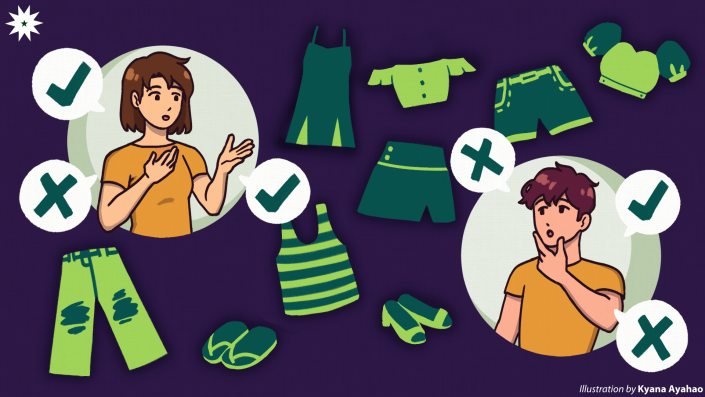The University has not enforced the dress code since, but a formal announcement regarding the policy’s status is yet to be found anywhere.
At present, there is still no clarity on the future implementation of the dress code in the University, but the student body has expressed strong perspectives regarding its necessity. These boil down to factors such as inclusivity, gender expression, double standards, and the appropriateness of certain types of clothing.

Pre-pandemic enforcement
The Student Discipline Formation Office (SDFO) has strictly implemented the dress code before the two-year halt of face-to-face classes, with even many professors continuing to enforce it during online classes. Historically, it has been a prominent subject of debate among the Lasallian community; for the discussions on the student handbook revisions for 2015, the University Student Government (USG) held open fora, distributed surveys, and even used social media hashtags to gather insights on the policy, among others, gathering opposing opinions on the dress code.
In 2018, Alyansang Tapat sa Lasallista released a manifesto calling for dress code abolishment, stating that it is “a movement towards a University that advocates for gender equality.” Students who participated in The LaSallian’s own opinion-gathering for the USG elections expressed the same.
Section 4.1 of the 2018-2021 DLSU Student Handbook notes that students may attend school dressed according to their individual preferences, but the SDFO in a policy reminder from 2019 stressed that they are encouraged to wear “decent and modest” attire. Students were prohibited from wearing certain styles of clothing that the University deemed inappropriate and inconsistent with DLSU’s Catholic nature and emphasis on professional development.
Allysa* (IV, PHY-PMD) recalls her experience with the implementation of the policy during her freshman year. “It used to be really strict. I had friends and classmates who got dress-coded a lot of times,” she recalls, adding that she personally experienced being policed for wearing shorts that were just a bit above her longest finger when standing, as this was one of the SDFO’s bases in determining the appropriateness of garment length.
Section 5.3.2.26 of the same handbook version states that second and succeeding violations of the dress code are minor offenses, and it can be recalled that the policy was on a strict “no compliance, no entry” condition. Allysa recounts that campus guards would sometimes advise students to fix their clothing to abide by the guidelines instead of being barred at the gates.
“If the outfits looked like clear violations, then we would have the choice to cover up or change outfits and then come back,” she explains. “They [would] encourage us to wear something that looks appropriate as defined sa rules para makapasok sa campus.”
(…as defined in the rules, so we can enter the campus.)
The Student Handbook Revisions Committee refused to comment on the dress code policy’s status and whether the current leniency will be permanent. However, they confirmed to The LaSallian that its future implementation would be clarified once the newly revised Student Handbook is released.
Students’ verdict
The leniency of the student dress code enforcement has led to an apparent change in student experience. Many students agree with its supposed abolishment, with Eze Andres (IV, BSA) sharing that the student body appears more expressive without the dress code.
“Mas uniform nga ang appearance ng students back then; but now, having no dress code allows the newer batches to be more inclusive and actually reflect how they want to be perceived,” Andres says.
Andres and Diane Therese Huldong (II, AB-ISE) emphasize inclusivity in the recent leniency. “The abolishment caters to everyone in DLSU because there are no prohibitions [on clothing] and it does not exactly discriminate on the person’s status, as the specifications are also waived,” Huldong remarks.
Albert* (V, AB-ISJ) points out the double standards in the past years of the student dress code, suggesting that abolishing the dress code is a “step in the right direction in achieving gender equality.” He elaborates, “On multiple occasions, the people who I saw getting called out were women who wore crop tops or mini-skirts. I find that the callouts are sexist because I don’t see men getting called out for the clothes they wear.”
However, not all students share the same sentiment. Rose* (III, AB-ISE) has some reservations regarding the leniency, bringing up the cross-dressing incident during the Animo Pep Rally in September 2022 as a point of consideration on the topic of the dress code.
“I would want the University to look into cases of mockery of cross-dressing…Despite liking the idea of the abolishment of the dress code and [having] freedom of expression, there should be limitations to how people dress, especially if their only intention is to mock and make people feel uncomfortable because of it,” she explains.
Alex* (IV, BSA), on the other hand, says that she is not at all in favor of the lack of dress code in the University.
“Without the dress code, students can dress however they want, and sometimes hindi na appropriate for school ang styles. Some students wear extremely revealing outfits.
Given [that] DLSU is still a learning environment, we have to wear clothes that [are] suitable for school,” she argues. “I like how the students are more expressive now pero there should be a limit that determines kung ano ang proper attire in an educational setting.”
Huldong offers a different perspective, stating that “Youth culture thrives in liberal universities like La Salle, and I think ‘inappropriate’ does not have a place in the discussion.”
*Names with asterisks (*) are pseudonyms.
